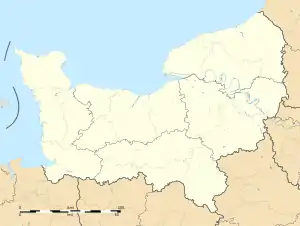Luneray | |
|---|---|
 The Protestant temple in Luneray | |
 Coat of arms | |
Location of Luneray | |
 Luneray  Luneray | |
| Coordinates: 49°49′45″N 0°54′51″E / 49.8292°N 0.9142°E | |
| Country | France |
| Region | Normandy |
| Department | Seine-Maritime |
| Arrondissement | Dieppe |
| Canton | Luneray |
| Intercommunality | CC Terroir de Caux |
| Government | |
| • Mayor (2020–2026) | Guy Auger[1] |
| Area 1 | 5.08 km2 (1.96 sq mi) |
| Population | 2,170 |
| • Density | 430/km2 (1,100/sq mi) |
| Time zone | UTC+01:00 (CET) |
| • Summer (DST) | UTC+02:00 (CEST) |
| INSEE/Postal code | 76400 /76810 |
| Elevation | 66–100 m (217–328 ft) (avg. 83 m or 272 ft) |
| 1 French Land Register data, which excludes lakes, ponds, glaciers > 1 km2 (0.386 sq mi or 247 acres) and river estuaries. | |
Luneray (French pronunciation: [lunʁɛ]) is a commune in the Seine-Maritime department in the Normandy region in northern France.
Geography
A small town of farming and light industry situated in the Pays de Caux, some 11 miles (18 km) southwest of Dieppe at the junction of the D70, the D4 and the D27 roads. The commune is also served by the TER railway.
Heraldry
 Arms of Luneray |
The arms of Luneray are blazoned : Quarterly 1: Per chevron argent and gules; 2: Gules, a chevron between 3 wolf heads Or; 3: Or, 3 lions sable; 4: Argent, 3 ermine spots sable.
|
Population
| Year | Pop. | ±% p.a. |
|---|---|---|
| 1968 | 1,782 | — |
| 1975 | 1,736 | −0.37% |
| 1982 | 1,807 | +0.57% |
| 1990 | 2,006 | +1.31% |
| 1999 | 2,167 | +0.86% |
| 2007 | 2,091 | −0.45% |
| 2012 | 2,147 | +0.53% |
| 2017 | 2,211 | +0.59% |
| Source: INSEE[3] | ||
Places of interest
- The church of Notre-Dame, dating from the sixteenth century.
- An eighteenth-century Protestant church. Luneray is one of the few Norman communes to have a significant Protestant population. The first French Sunday school was opened Luneray, August 7, 1814 by Pastor Laurent Cadoret, who built the temple with his parishioners
See also
References
- ↑ "Répertoire national des élus: les maires" (in French). data.gouv.fr, Plateforme ouverte des données publiques françaises. 13 September 2022.
- ↑ "Populations légales 2021". The National Institute of Statistics and Economic Studies. 28 December 2023.
- ↑ Population en historique depuis 1968, INSEE
Wikimedia Commons has media related to Luneray.
This article is issued from Wikipedia. The text is licensed under Creative Commons - Attribution - Sharealike. Additional terms may apply for the media files.